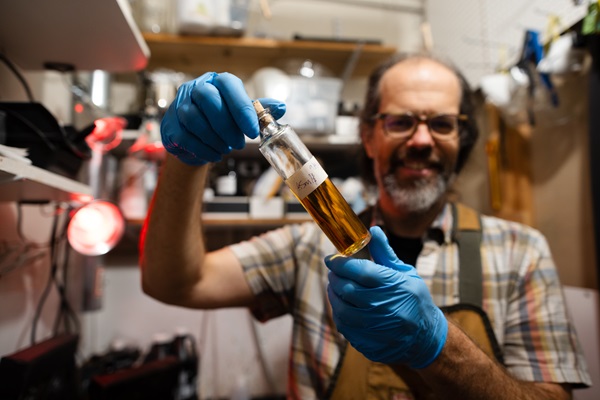Photos by Paige Green Photography
Photographer Annie Leibovitz once said, “A photograph is just a tiny slice of a subject. A piece of them in the moment. It seems presumptuous to think you can get more than that.” But Jeremiah Flynn’s enigmatic tintype photos prove the contrary. Although technically a moment in time captured, his tintypes read like memoirs of their subjects—entire life spans contiguous with constellations of freckles, wrinkles, and scars. Their appeal exists in a both/and flux of opposites: sort of distant in their long-ago feel yet incredibly intimate, hyper-realistic yet otherworldly, soft yet stark, gritty yet refined, simple yet profound. Power, pride, pain; love, laughter, loss—everything is laid bare.
Jeremiah refers to the wet plate collodion process more commonly known as “tintypes” as “part photography, part alchemy, with a touch of dexterity and finesse.” A direct positive image on a sheet of metal (an odd misnomer as corrodible tin was never used), tintypes revolutionized photography in the 1850s, largely because they didn’t rely on the bath of simmering mercury vapor necessary for prominent predecessors like daguerreotypes. The method’s relative speed and portability lent to it being widely used at traveling fairs and carnivals, where everyday folks suddenly had the opportunity to have their photo taken, often for the first time.
“The process resonates with me,” Jeremiah says, “because it allows me to entertain my inner photo craftsman as well as my curious people-watching sociologist, and my repressed mad scientist.”
Without getting into the technical weeds, I’ll say that the process of producing a tintype requires careful timing and a Goldilocks-esque balance of countless variables. The plate must be prepared right before the photo is shot (with gelatinous goo containing suspended silver salts) and then immediately developed while still wet. Due to the film’s sensitivity, there needs to be a generous amount of light or a very long exposure, which is why many associate the old-timey photos with having to sit perfectly still for a lengthy amount of time to capture an image. In his studio, Jeremiah opts for the light, drenching his subjects in heavy doses. He says the experience is like “a glimpse of heaven.”
Quite the opposite of a fast-shooting digital photo session, where hundreds of images can be taken within minutes, the tintype pace is much more deliberate. When you sit for a session with Jeremiah, you are along for a 90-minute journey that results in just three images, each fit to withstand the next untold hundreds of years onward. Jeremiah delights in answering questions and being joined in the darkroom to watch the mysterious magic unfold. As the striking portraits emerge under red safelights, it is not such a stretch to empathize with those who once feared that the images contained captured souls.
When I ask if he thinks there is more soul in tintype photos, he responds, “They are more intentional, both on my part and the other’s.” Often people come for the tintypes when they are upon a milestone moment: a big-number anniversary or a divorce that just got finalized or chemo just started or chemo completed. One customer arranged a tintype session for his aging parents, but when he picked up the finished portraits, he didn’t even take a look, telling Jeremiah that he was saving the experience for once they were gone. “It’s been a wild ride. Let’s just say, I’m not sitting around taking headshots for realtors,” he tells me through palpable emotion.
Jeremiah’s studio is adjacent to his funky and fabulous photo corner at the heart of Santa Rosa’s South A Arts District. The hub for film heads and photo geeks, it is not uncommon to see the tiny place packed with convivial regulars during business hours—some of them even there to buy things. Jeremiah sells vintage and collectable film cameras and accoutrement on a razor-thin margin; but, above all, he offers a sense of place and purpose for those who could have easily been washed away by the digital-age tide.
Although some, including his accountant, were openly incredulous when Jeremiah decided to hang his shingle on the photo corner 14 years ago, his regular customers get it, considering the spot a touchstone for the local photographic community. Long-time friend and employee Andie Thornton tells me, “You can get a used camera anywhere if you really want to, but people come here because Jeremiah makes them feel special and cared for. It’s just a messy-ass camera store, but people love him.” She thinks this is the fundamental element that makes his tintypes so stunning.
“It is because he is on the other side of the camera and he brings out the very best in people,” Andie says, adding, “Jeremiah has a lot of heart. The way he does anything is the way he does everything.”
411
441 Sebastopol Ave, Santa Rosa.









